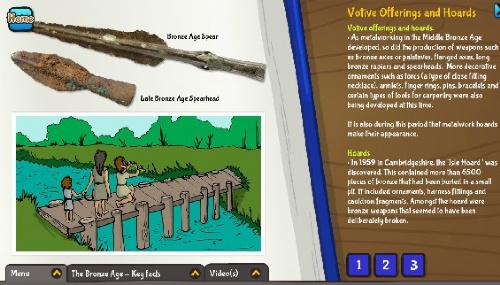The Bronze Age
The first significant written record of Britain and its inhabitants was made by the Greek geographer and explorer Pytheas navigator who explored the coastal region of Britain around in the early part of the 4th century BC.
This may be the first written record of a Britain from the sea by a Greek navigator, but evidence of Britain and contact with Europe which is much earlier can be seen in the Bronze Age grave of the Amesbury Archer discovered in 2002.
The grave itself contained over a hundred items, and is the most richly furnished Beaker grave yet to have been found in Britain. Chemical studies of his teeth showed that he originally lived in an area somewhere between Sweden and the Alps.
The heritage interactive included a series of short films, with archaeologist Mark Corney from Time Team

Votive offerings and hoards.
As metalworking in the Middle Bronze Age developed, so did the production of weapons such as bronze axes or palstaves, flanged axes, long bronze rapiers and spearheads, as well as more social or personal ornaments including torcs, armlets, finger rings, pins, bracelets and certain tool for carpentry. It is also during this period that metalwork hoards make their appearance.

Hoards
In 1959 in Cambridgeshire the Isle hoard was discovered. This contained more than 6500 fragments of bronze which had been buried in a small pit which included ornaments, harness fittings and cauldron fragments. Amongst the hoard were bronze weapons that seemed to have been deliberately broken.
Other sites have been located around Britain where similar artefacts or votive offerings have been discovered, such as Testwood in Hampshire, Vauxhall in London, Eton Rowing Lake in Berkshire.
In Flag Fen in Cambridgeshire, a bronze sword which had never been sharpened was deposited, along with hundreds of other bronze objects including bracelets, chisels as well as other tools, swords, axes and spears. Many of the swords had been snapped or broken in the middle not from accident or misuse but deliberately.
It may be that these rich artefacts were broken and discarded in a similar way to us throwing money down a modern wishing well possibly to the gods in return for protection, a long life or a celebration of a significant act such as a marriage or the end of a relationship through death.
Some people believe that large amounts of metal objects were deliberately taken out of circulation and then buried so that the objects remained scarce and therefore more valuable
All the topics can be found on: